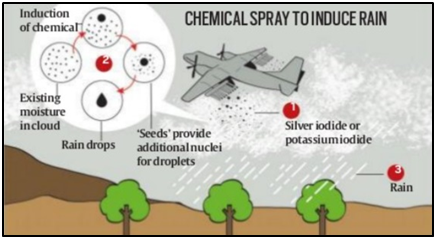Delhi govt plans ‘cloud seeding’ to induce rains amid pollution
14-11-2023
05:28 AM

What’s in today’s article?
- Why in news?
- Cloud Seeding
- What is cloud seeding?
- Conditions required for cloud seeding
- Previous instances of cloud seeding in India
- What are the challenges of cloud seeding?
- Is cloud seeding expected to help with pollution levels?

Why in news?
- The Delhi government had announced that it was considering cloud seeding or ‘artificial rain’ to wash away pollutants in the air.
- The equipment, an aircraft and, more importantly, the seed are already available.
- However, the authorities are waiting for the conditions – at least the presence of clouds – to become favourable to induce rain through cloud seeding.
What is cloud seeding?
- Background
- Water vapour condenses around small particles to form the droplets that make up a cloud.
- These droplets collide and grow; as they get heavy and the cloud gets saturated, it rains.
- Cloud seeding
- Clouds are usually injected with salts like silver iodide, potassium iodide, or sodium chloride, which is the ‘seed’.
- They are dispersed into the cloud either using aircraft or through generators on the ground.
- These salts are expected to provide additional nuclei around which more cloud droplets can form.
- Clouds are usually injected with salts like silver iodide, potassium iodide, or sodium chloride, which is the ‘seed’.
- Significance of the process
- Seeding accelerates cloud microphysical processes.
- Sufficiently large droplets are needed that can reach the surface of the earth and not evaporate on the way.
- Hence, substance that is dispersed into the cloud needs to have cloud condensation nuclei and ice nuclei and these two come from two different salts.
- The cloud condensation nuclei help form cloud droplets, and ice nuclei help to form ice crystals.
- Ice crystals grow faster than drops, and they become large and fall.
- Seeding accelerates cloud microphysical processes.
Conditions required for cloud seeding
- Firstly, cloud cover and clouds of a certain type are necessary.
- Cloud seeding can only happen if there is a sufficient number of clouds and a particular depth to these clouds.
- Inside, there needs to be an adequate number of cloud droplets.
- Cloud seeding is done to increase the radius of the cloud droplets so that they will grow bigger and because of gravity, they will come down as rainfall.
- In winter, clouds form over Delhi when a western disturbance moves over the region.
- Western disturbances are storms that originate in the Caspian or Mediterranean Sea and bring non-monsoonal rainfall to northwest India.
- These disturbances bring rain to northwest India.
- In winter, when the atmosphere is stable, clouds form when a western disturbance disrupts this stability.
- In simpler terms, western disturbances are responsible for winter clouds in Delhi, even though they may not be the right type for cloud seeding.
- Additionally, factors like cloud height and water content need to be considered even if clouds are present.
Previous instances of cloud seeding in India
- During monsoon season
- Seeding has mostly been attempted during the monsoon in India, in places such as Karnataka, Maharashtra and Tamil Nadu.
- The fourth phase of the Cloud Aerosol Interaction and Precipitation Enhancement Experiment (CAIPEEX-IV)
- CAIPEEX-IV was conducted in drought-prone Solapur in Maharashtra in monsoon seasons of 2018 and 2019.
- It pointed to a relative enhancement of 18 per cent in rainfall.
- Experiments by IIT Kanpur
- IIT Kanpur attempted it in April and May of 2018, which are the pre-monsoon months, on their campus. It said five out of six trials resulted in rain.
Challenges
- The science of cloud microphysics is more intricate than anticipated.
- While there may be some benefits during the monsoon season if there are sufficient clouds, it is important to note that not all seeded clouds result in rain, and natural rainfall can occur without seeding.
- Overall, cloud seeding remains a complex and uncertain area of research.
Is cloud seeding expected to help with pollution levels?
- In India so far, cloud seeding has not been tried with the purpose of reducing pollution, but only been tried to deal with drought-like conditions.
- There are a few cases where China tried weather management options for reducing pollutions. However, Indian conditions are different, and we will need a dedicated study on this.
- As per experts, there should be a significant amount of rain so it washes away pollutants. It will only be temporary, but if at all it is successful, it will break the flow of pollutants.
Q1) What is the fourth phase of the Cloud Aerosol Interaction and Precipitation Enhancement Experiment (CAIPEEX-IV)?
The fourth phase of the Cloud Aerosol Interaction and Precipitation Enhancement Experiment (CAIPEEX-IV) was a scientific investigation conducted in Solapur, Maharashtra during the 2018 and 2019 summer monsoons. The experiment was conducted by the Indian Institute of Tropical Meteorology (IITM), Pune.
Q2) What is Mediterranean Sea?
The Mediterranean Sea is a large inland sea that stretches from the Atlantic Ocean to Asia and separates Europe from Africa. It is surrounded by the Mediterranean Basin and almost completely enclosed by land. The Mediterranean Sea is linked with the Atlantic by the Strait of Gibraltar, with the Red Sea by the Suez Canal, and with the Black Sea by the Dardanelles, Sea of Marmara, and Bosporus.
Source: Delhi govt plans ‘cloud seeding’ to induce rains amid pollution: What is this process? | Indian Express


